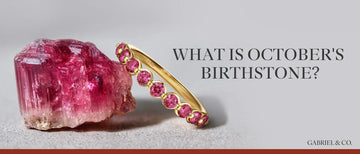
October brings a symphony of change - from summer's bright lushness to the mellowed scarlet and golden warmth of fall. The soothing gold color of fall leaves echoes that ends can be stunning, too, and a worthy reason for celebration. From pumpkin spice lattes and Halloween to the fall foliage, October gives us many reasons to rejoice. And to top it all, the month has not one but two sparkling birthstones - Opal and Tourmaline, both just as calm and reassuring as fall itself. Read on as we delve deeper into October’s birthstone meaning, history, and interesting facts.
Is the birthstone for October opal or tourmaline?
It is BOTH.
October babies get double the gems!
Unlike most months with a single birthstone, October is blessed with two - Opal and Tourmaline. These glistening stones are certainly off the beaten path and speak of the unique attributes of October-born: grounded, charming, and affable.
The earliest birthstone records date to the early 1900s when the National Association of Jewelers of the United States formalized a list of birthstones for each month. Except for three months (March, August, & October) with two birthstones and two months with three birthstones (June & December). Although confusing, two stones for a single month allowed people to choose one over the other based on their tastes and budget.
The oddity of having two birthstones for October has an explanation. The primary birthstone for October is opal. However, concerns were raised about the durability of this gorgeous stone and its association with feminine features. The National Association of Jewelers added tourmaline to its list of gemstones, alongside opal. As a result, opal and pink tourmaline, specifically, are now recognized as October birthstones.
“Keep calm and let October shine with illuminating opals and tourmalines!”
Here is everything you need to know about glitzy, iridescent October birthstones.
October’s opal
They say October is the “opal month of the year,” and for good reason. Let’s start our list with Opal - the first of October’s birthstones.

History of the opal stone
Opal is one of the most elegant and regal-colored gemstones, loved by royalty for centuries. The traditional October birthstone has a rich history and a wealth of lore surrounding it. Queen Victoria was enchanted by the pearlescent glitz of this enigmatic stone, harboring a borderline obsession with it. A little stroll back in time reveals that even the Romans loved opals. According to legend, one Roman Emperor bargained to exchange one-third of his empire for a single Opal. Mark Antony was fond of precious opals and left a collection for his beloved Cleopatra.
Opal's origins can be traced back to ancient Ethiopia. However, Australia dominated opal production in the late 1800s, and Australian opals were first featured on the global market in the 1890s. Today, South Australia accounts for more than half of the world's opal production.

Opal meaning and symbolism
Opal is the primary and most well-known October birthstone, derived from the Greek word opallios, which means "to see a color change." The modern name of opal is also related to the ancient Sanskrit term Upala, which means "precious stone." The term "opalus" was also used in ancient Roman culture to mean prized-possession and power.
Opals represent the "dramatic play of color" that has inspired poets and authors to compare them to firecrackers, volcanoes, and galaxies. In Middle Ages folklore and legend, the opal was revered as the bringer of good fortune. The Bedouins (nomadic Arab tribes) believed that this kaleidoscopic gem fell from the sky during thunderstorms, contained lightning, and had the cumulative qualities of all colored stones.

Opal deposits
This traditional birthstone of October is mined across various countries like Brazil and Mexico. In the 1850s, Australia rose to the top of the chart as the center of opal deposits. The most prized black opal is also mined in Lightning Ridge, New South Wales, and Australia. But more recently, the Ethiopian opal, also known as the Welo opal, was found in the Ethiopian province of Wollo. Because of its striking hues and patterns, this new variety of opals is highly sought after.
Let us share a bit of trivia with you.
Opal can be found in other places besides our planet. It’s found on Mars, too. Scientists' discovery of opal deposits on Mars in 2008 suggests that there may have once been life there because opal is created when water evaporates, leaving silica behind.
Care and Cleaning
The best way to clean opal is with soap and warm water. However, excessive exposure of your opal jewelry to water will destabilize the sealer in opal doublets and triplets. This stone needs maintenance as it scores a 5 to 6.5 on the Mohs scale of hardness. Keep it out of direct heat and high temperatures to avoid cracking or fractures.
Opal fun facts
- A 1 cm length of opal takes at least 5–6 million years to form.
- This gemstone is linked to loyalty, fortune, and self-assurance.
- Opals are given as a gift to mark the 14th wedding anniversary.
- Opals come in two varieties: common and precious.
- The gemstone is available in numerous colors.
- Opal is the national gemstone of Australia.
- Just like diamonds, opals can also be lab-grown.
- The most uncommon variety of opal is black opal.
- The Virgin Rainbow is the most valuable and prized opal in the world

14K Yellow Gold 3MM Bezel Opal Studs
The new October birthstone: What is tourmaline?
Ravishing and vibrant, tourmaline was later declared the second birthstone for October. Denoting the Sinhalese term toramalli, standing for “stone with mixed colors,” tourmaline is as captivating as opals.

History of the tourmaline stone
The discovery of tourmaline occurred in the 1800s, when scientists began to differentiate this stone from other precious stones. But long before this, in the 1500s, a Spanish explorer discovered green tourmaline in Brazil, mistaking it for the green emerald. Before the 1400s, black tourmalines were known as "schorl." In the 1600s or early 1700s, Dutch traders found the stone off the West Coast of Italy for the first time. And from Sri Lanka (formerly Ceylon), tourmalines were brought to Europe by the Dutch East India Company.
The stone's popularity skyrocketed with the discovery of American tourmaline deposits. In 1876, the green tourmaline was widely advertised as the “American Gem.”
Tourmaline color
Pink and red rubellites, chrome and neon green tourmalines, and blue-to-violet "paraba" tourmalines are among the most popular colors of this October stone. Tourmalines are also gifted on eighth wedding anniversaries.

Tourmaline meaning and symbolism
The beauty of this stone once inspired poets and artists. Tourmaline was connected to creativity from the Renaissance to the Victorian era. Tourmaline was used as a talisman by writers such as Shakespeare to help them articulate their creative side better.
The stone is also thought to have therapeutic properties. For example, Dutch scientists asserted that placing a tourmaline wrapped in silk against a feverish child's cheek stimulates sleep. Similarly, the stone was used in Africa to revive people from "the dream of illusion." Tourmaline was also used as a charm by Aboriginals, Native Americans, and African Tribes to provide "protection from all dangers."
Based on centuries of folklore, different colors of tourmaline represent different attributes.
- Black- Protection and self-confidence
- Pink- Compassion and gentleness
- Green- Courage, stamina, and strength
- Blue- Calmness and stability
- Red- Inner strength and wisdom
- Brown- Emotional balance
Care and cleaning
With a hardness of 7 to 7.5 on the Mohs scale, tourmaline jewelry is suitable for daily wear. However, be cautious to keep this gemstone away from heat. To clean this October gem, use warm, soapy water and a soft-bristle brush. There should be no scrubbing, but gentle brushing is recommended.

Tourmaline fun facts
- The stone shows no fissures or cracks and is less brittle than other gemstones.
- Tourmaline is believed to be laden with spiritual powers that boost self-esteem.
- It is not a traditional birthstone.
- Tourmaline is for people born under the zodiac sign Libra.

Platinum Pink Tourmaline Ring with Pear Diamond Accents
FAQs
Why does October have two birthstones?
October originally had opal as its primary birthstone, but pink tourmaline was later added as a modern alternative for people who prefer a more durable or colorful option.
What’s the difference between opal and tourmaline?
Opal is known for its shifting rainbow-like play of color, while tourmaline comes in solid shades, especially pink, green, and watermelon (pink with green edges). Opal is softer and more delicate, while tourmaline is more durable for daily wear.
Is opal bad luck if it’s not your birthstone?
This superstition came from Victorian-era fiction, not fact. Historically, many cultures believed opal brought protection and good fortune to anyone who wore it.
Can I wear opal every day?
You can, but it requires care. Opals contain water and are more prone to cracking or scratching. Choose protective settings or opt for tourmaline if you want something lower maintenance.
Do opals lose their color over time?
High-quality opals can stay vibrant for decades as long as they’re kept away from extreme dryness and sudden temperature changes.
What does the October birthstone symbolize?
Opal is associated with creativity, passion, and emotional healing. Pink tourmaline is linked to love, compassion, and balance.
Are natural opals better than lab-created ones?
Natural opals are rarer and more valuable, but lab-created opals offer similar beauty with more durability and an affordable price tag.
What’s the most valuable type of opal?
Black opal from Lightning Ridge, Australia, is considered the rarest and most valuable.
Written By: Gabriel Editorial Team






























